ASRock Fatal1ty Z77 Professional Review - IDE and Floppy on Z77
by Ian Cutress on May 20, 2012 1:30 PM EST- Posted in
- Motherboards
- ASRock
- Fatal1ty
- Z77
USB Speed
For this benchmark, we run CrystalDiskMark to determine the ideal sequential read and write speeds for the USB port using our 240 GB OCZ Vertex3 SSD with a SATA 6 Gbps to USB 3.0 converter. Then we transfer a set size of files from the SSD to the USB drive using DiskBench, which monitors the time taken to transfer. The files transferred are a 1.52 GB set of 2867 files across 320 folders – 95% of these files are small typical website files, and the rest (90% of the size) are the videos used in the Sorenson Squeeze test.


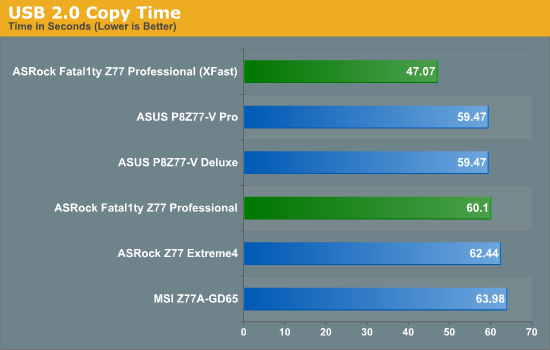
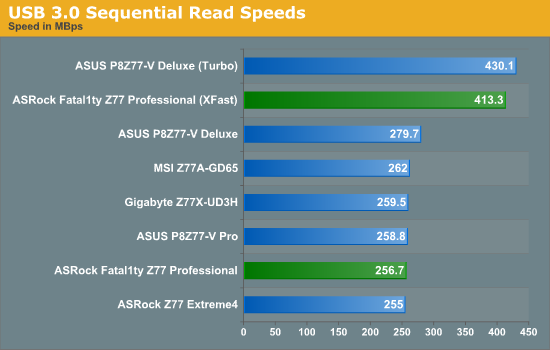
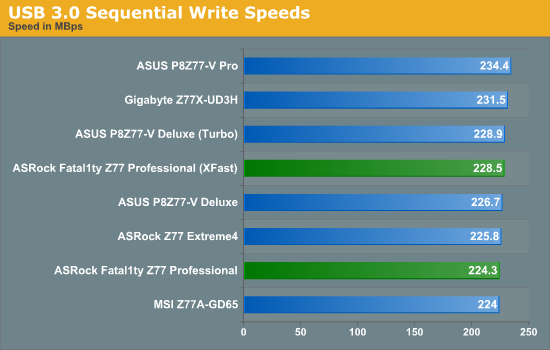

While the XFast implementation clearly makes the ASRock pull ahead of all the standard solutions of other motherboards, the default performance of the ASRock is a little disappointing. The USB 2.0 results in particular, as all the other manufacturers have at least another 1 MBps read speed on the ASRock implementation.
SATA Testing
We also use CrystalDiskMark for SATA port testing on a C300 drive. The sequential test (incompressible data) is run at the 5 x 1000 MB level. This test probes the efficiency of the data delivery system between the chipset and the drive, or in the case of additional SATA ports provided by a third party controller, the efficiency between the controller, the chipset and the drive.
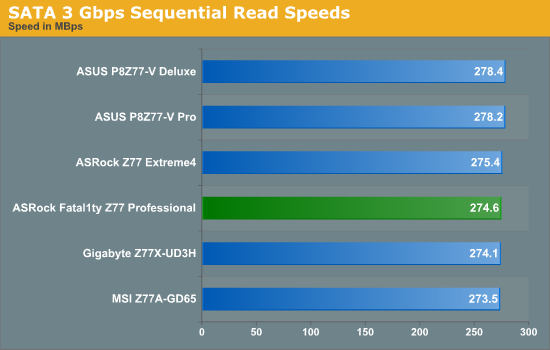
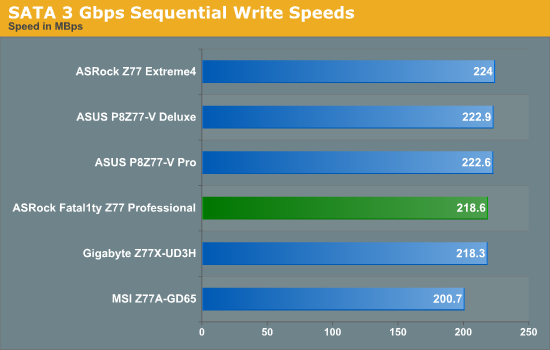
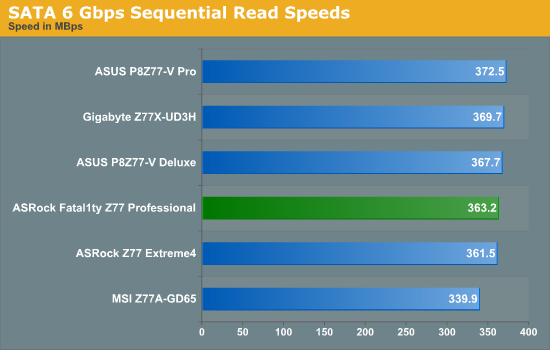
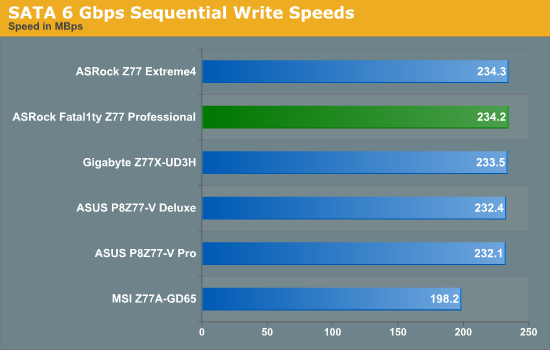
Nothing much to compare with regards to the SATA implementations between the boards.
DPC Latency
Deferred Procedure Call latency is a way in which Windows handles interrupt servicing. In order to wait for a processor to acknowledge the request, the system will queue all interrupt requests by priority. Critical interrupts will be handled as soon as possible, whereas lesser priority requests, such as audio, will be further down the line. So if the audio device requires data, it will have to wait until the request is processed before the buffer is filled. If the device drivers of higher priority components in a system are poorly implemented, this can cause delays in request scheduling and process time, resulting in an empty audio buffer – this leads to characteristic audible pauses, pops and clicks. Having a bigger buffer and correctly implemented system drivers obviously helps in this regard. The DPC latency checker measures how much time is processing DPCs from driver invocation – the lower the value will result in better audio transfer at smaller buffer sizes. Results are measured in microseconds and taken as the peak latency while cycling through a series of short HD videos - under 500 microseconds usually gets the green light, but the lower the better.

The DPC timings on Ivy Bridge are exceptional – not one board has yet achieved slower than 120 microseconds. The Fatal1ty puts in a good show, just missing out on a sub 100-microsecond timing.










57 Comments
View All Comments
kevith - Monday, May 21, 2012 - link
Yeah, that struck me as well.scaramoosh - Sunday, May 20, 2012 - link
I wont buy anything branded by that loser who hasn't really competed since 2005.Iketh - Sunday, May 20, 2012 - link
someone sounds bitter lolhaters gonna hate!
Friendly0Fire - Monday, May 21, 2012 - link
I wouldn't call him a loser, but I too would rather like the Fatal1ty crap toned down a bit. I've never seen him play, I actually don't give a damn about him, so his likeness appearing on products that I otherwise could want to buy feels more like excessive branding than anything else.I can see why he's on them, of course: he did a lot of firsts and his nickname is marketable (it's got a bit of a "leetspeak" feel, which apparently appeals to a certain audience, it's "edgy" but still family-friendly, etc.). As much as I respect Starcraft players, I don't think NesTea or Stephano-branded hardware would sound good.
Reikon - Sunday, May 20, 2012 - link
I've always wondered if Fatal1ty branding actually convinced anyone to buy something. It usually just drives me away since it seems more like a branding gimmick for something that can't stand on its own.Camikazi - Monday, May 21, 2012 - link
That is like asking if Michael Jordan branded shoes, or Tony Hawk branded skateboard ever prompted someone to buy them. The answer is easy, OF COURSE IT DOES, there are always people who don't know enough about things that go for celeb branded items because the celebs endorsed it. They don't know or care enough to find out that there are cheaper parts that are as good or better out there they just want the name.Matt355 - Monday, May 21, 2012 - link
Thought I was the only one that felt that way.FozzyofAus - Sunday, May 20, 2012 - link
I also don't see the point of an IDE or Floppy port.How about a review of the uATX version of the board? I'm not convinced that many people really need a full ATX board anymore.
iamkyle - Sunday, May 20, 2012 - link
Seriously Jon? You "consultations" with manufacturers lead you to add long gone legacy floppy and IDE?Somebody PLEASE make me an enthusiast board with barebones I/O - USB only. Let me choose my NIC & my sound MYSELF. As a TRUE enthusiast would.
jabber - Monday, May 21, 2012 - link
Exactly a real hardcore gamers board would be stripped of everything not required to just get the PC up and running.Then you would have a board with the minimum of traces and junk on it for the best performance. No fat at all. Then add just the hardware you need and nothing else.